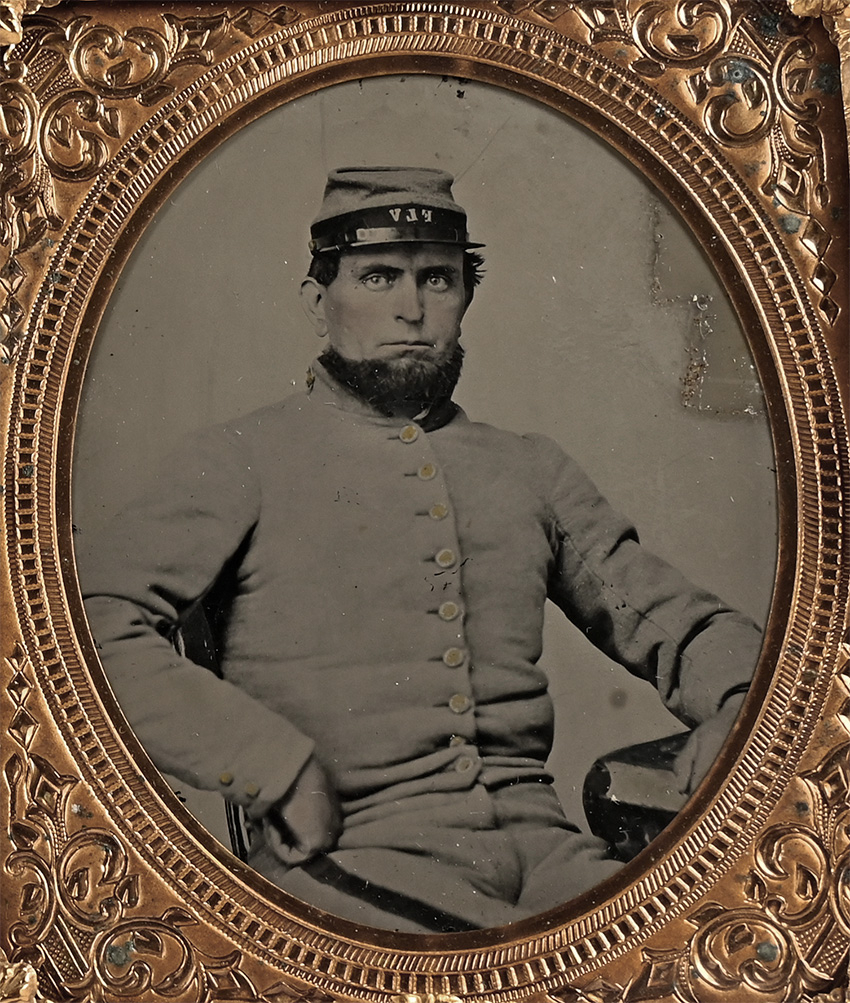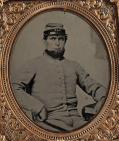site search
online catalog
AN IMPOSING FIGURE: ABRAHAM GROSS, CO. B, 4th VIRGINIA INFANTRY, THE FORT LEWIS VOLUNTEERS, STONEWALL BRIGADE, FIRST BULL RUN!

$5,500.00 SOLD
Quantity Available: None
Item Code: 1138-1948
The Confederate soldier in this ultra-clear 6th plate ambrotype is identified by a family note in the back of the case and the initials of his company’s local designation spelled out in brass letters on the front of his cap. He is shown half-length, seated, with one elbow resting on a table beside him and the other bent as he rests his hand on his hip. He wears a gray jacket with nine-button front and two cuff buttons. His trousers show a dark stripe of medium width up the seam. The jacket does not seem to be trimmed. The photographer has lightly tinted his button gold. He wears a gray kepi with chinstrap and dark band around the base, on which are mounted the brass letters “FLV.” The photographer has delicately tinted his cheeks red. He wears a wide chin beard and stares into the camera lens, slightly up and to the left, with an expression that, if not a scowl, is darn close to one.
The note with the photograph reads, “Fred’s Grandfather / Gross.” Amann’s list of local designations gives only one possibility for the unit: the “Fort Lewis Volunteers,” who became Co. B of the 4th Virginia, and Abraham Gross hits dead-on in the company roster. He was born in Bedford County, Va., and worked on his father’s farm along with his six brothers and 3 sisters into the 1850s. By 1860 he was married, with 2 sons and 2 daughters, ages 2 to 7, and owned a farm in Montgomery County, likely at Big Spring (now Elliston,) where he enrolled at age 37 on 4/18/61 in Captain David Emundson’s company of infantry, the Fort Lewis Volunteers, for one year’s service. Both his age and physical description fit his portrait: he stood 6’ 2 ½” with dark hair, eyes and complexion.
He was mustered in on April 26 at Richmond and the company officially became Co. B of the 4th Virginia about July 1. They saw action just three weeks later, arriving by train at Manassas on July 20 and fighting on Henry House Hill in Jackson’s brigade, where Jackson and the brigade earned the nickname of Stonewall. The regiment suffered the highest casualties of the brigade in the fighting, some 31 killed and 100 wounded. In Spring 1862 they fought in Jackson’s Valley Campaign, seeing action at Kernstown, Front Royal, Winchester, and Port Republic. In the Peninsula Campaign of Summer 1862, they saw action at Gaines Mill and Malvern Hill.
Gross is noted as receiving a furlough in January 1862, but is marked present on muster rolls through March. On the March-April roll he is listed as absent without leave since April 21, but when he is discharged at Gordonsville on August 7, 1862, he is paid in full on August 16 from his last receipt of pay in March. His discharge refers to the Congressional Act of April 16, 1862. This extended service for Confederate soldiers in the ranks to three years from the date of their enlistment, but also instituted a draft of men aged 18 to 35, so Gross’s age may have resulted in his discharge.
CWData indicates his name also appears on a postwar roster of Co. G, 14th Va. Cavalry, though without any service dates and the compiled service records of the unit do not include him. Company G, however, included men from Montgomery County and was originally recruited as a company in the 7th VA Cavalry, noted as including many re-enlisted men of the 4th Infantry. Interestingly, the company was organized on April 16, 1862, at the same time as the Congressional Act and the period of Gross’s reported absence without leave. It is thus unclear if he joined that company after his service with the 4th or was mistakenly enrolled in it when first formed and then put back on the books of the 4th. His discharge and pay as a member of the 4th in August indicate he continued in that unit and likely served with it in the Valley and Peninsula Campaigns. He may also have seen action at Cedar Mountain August 9, two days after his official date of discharge. He was not officially paid off until August 16 and a genealogical site says he fought at First Manassas and “Cedar Run,” but also gives his discharge date as August 30, 1863, when his compiled service record clearly indicates he was discharged to date Aug. 7, 1862, and paid off August 16.
Gross returned to his farm and family in Montgomery County and we find him there in the 1870 and the 1880 census, when he and his wife are there with four sons and three daughters, ages 10 to 26, though they may have had as many as ten children altogether. The 1890 census is fragmentary and he is not in the 1900 census and so likely died before that date.
This is a great image with wonderful clarity, uniform detail, an imposing personal presence, and an interesting history that might also bear further research. [sr] [ph:M]
~~~~~~~~~~~~~~~~~~~~~~~~~~~~~~~~~~~
THIS ITEM, AS WITH ALL OTHER ITEMS AVAILABLE ON OUR WEB SITE,
MAY BE PURCHASED THROUGH OUR LAYAWAY PROGRAM.
CLICK HERE FOR OUR POLICIES AND TERMS.
THANK YOU!
Inquire About AN IMPOSING FIGURE: ABRAHAM GROSS, CO. B, 4th VIRGINIA INFANTRY, THE FORT LEWIS VOLUNTEERS, STONEWALL BRIGADE, FIRST BULL RUN!
For inquiries, please email us at [email protected]
Most Popular
Historical Firearms Stolen From The National Civil War Museum In Harrisburg, Pa »
Theft From Gravesite Of Gen. John Reynolds »
Selection Of Unframed Prints By Don Troiani »
Fine Condition Brass Infantry Bugle Insignia »
British Imported, Confederate Used Bayonet »
Scarce New Model 1865 Sharps Still In Percussion Near Factory New »
featured item
DAGUERROTYPE IN UNIFORM OF LEWIS HENRY LITTLE, BREVET FOR GALLANT AND MERITORIOUS CONDUCT AT MONTEREY 1846; KILLED IN ACTION AS CONFEDERATE BRIGADIER GENERAL AND DIVISION COMMANDER AT IUKA 1862
This very clear sixth-plate daguerreotype dates about 1850 and shows Lewis Henry Little, usually referred to by his middle name, as a Captain in the 7th U.S. Infantry. Born in Maryland in 1817, he was appointed 2nd Lieutenant in the 5th US Infantry… (1138-1808). Learn More »







